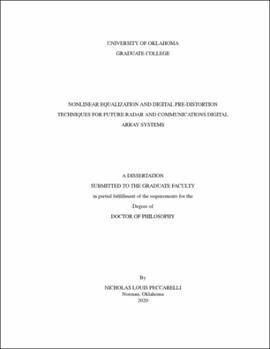| dc.description.abstract | Modern radar (military, automotive, weather, etc.) and communication systems seek to leverage the spatio-spectral efficiency of phased arrays. Specifically, there is an increasingly large demand for fully-digital arrays, with each antenna element having its own transmitter and receiver. Further, in order to makes these systems realizable, low-cost, low-complexity solutions are required, often sacrificing the system's linearity. Lower linearity paired with the inherent lack of RF spacial filtering can make these highly digital systems vulnerable to high-power interferering signals-- potentially introducing spectral regrowth and/or gain compression, distorting the signal-of-interest.
Digital linearization solutions such as Digital Pre-Distiortion (DPD) and Nonlinear Equalization (NLEQ) have been shown to effectively mitigate nonlinearities for transmitters and receivers, respectively. Further, DPD and NLEQ seek to extend the effective dynamic range of digital arrays, helping the systems reach their designed dynamic range improvement of $10\log_{10}(N)$~dB, where $N$ is the number of transmitters/receivers. However, the performance of these solutions is ultimately determined by training model and waveform. Further, the nonlinear characteristics of a system can change with temperature, frequency, power, time, etc., requiring a robust calibration technique to maintain a high-level of nonlinear mitigation.
This dissertation reviews the different types of nonlinear models and the current NLEQ and DPD algorithms for digital array systems. Further, a generalized calibration waveform for both NLEQ and DPD is proposed, allowing a system to maximize its dynamic range over power and frequency. Additionally, an \textit{in-situ} calibration method, leveraging the inherent mutual coupling in an array, is proposed as a solution to maintaining a high level of performance in a fielded digital array system over the system's lifetime. The combination of the proposed training waveform and \textit{in-situ} calibration technique prove to be very effective at adaptively creating a generalized solution to extending the dynamic range of future low-cost digital array systems. | en_US |
